Latest Supporters :
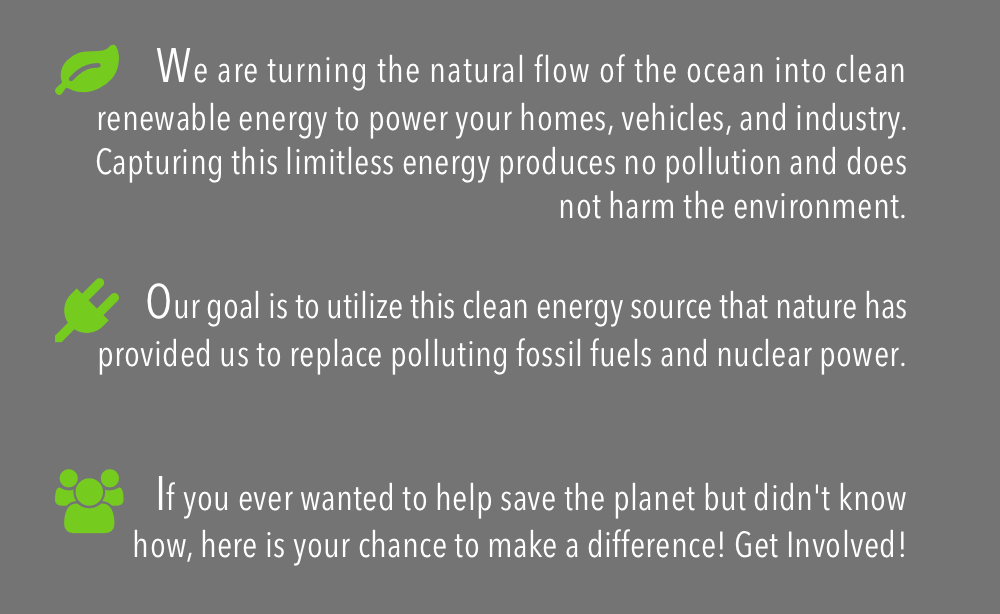
 [fve]https://vimeo.com/102900616[/fve]
[fve]https://vimeo.com/102900616[/fve] 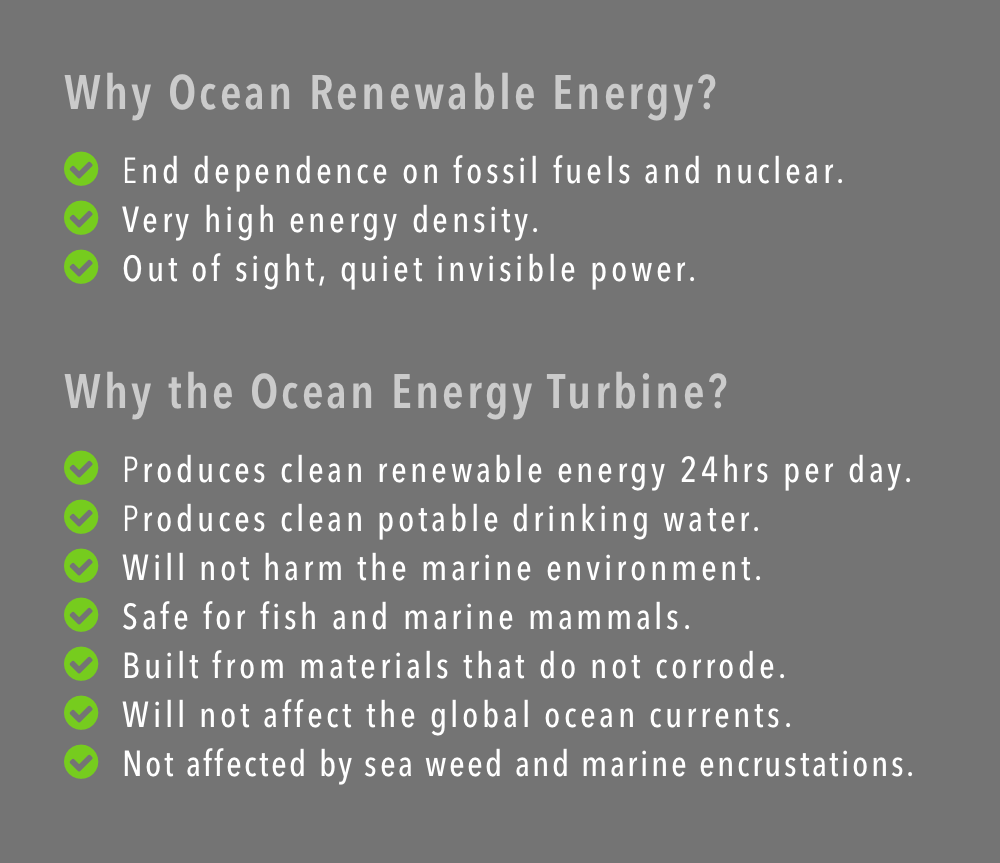
How will this make my life better?
What if you did not have to conserve energy? What if there was more energy than you could use? What if this new energy was cheap? What if this new energy did not fill your air with choking smog, your oceans with giant oil spills, and your drinking water with toxic chemicals?
Homes, vehicles, factories all powered by Clean Renewable Ocean Energy.
Imagine the joy of using as much energy as you need without the guilt attached of harming the environment.
Now imagine how much better the lives of future generations will be because we stopped polluting the planet that they will inherit.
These are the goals we are working toward but we need your help. We are asking you to do your part by enabling us to provide you and your family with a cleaner, smarter, more reliable, source of energy.
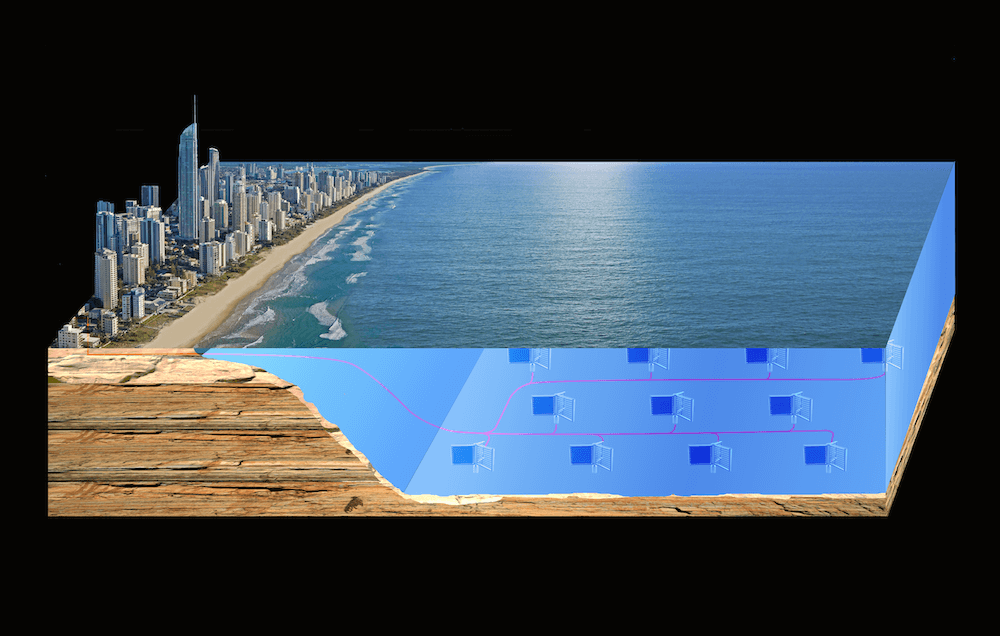
Why should I help?
The Ocean Energy Turbine is the first commercially viable clean renewable energy source that has the potential to compete with and eventually replace fossil fuels and nuclear energy dependence.
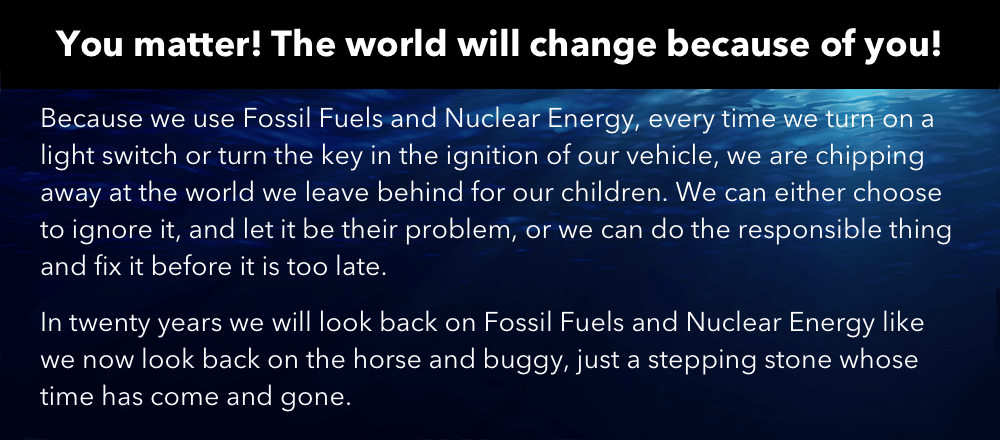
Who is involved?
Crowd Energy is a small collection of Engineers, Inventors, and Scientists. We have specialists in SubSea Engineering, Oceanography, Marine Ecology and Conservation, Electrical Engineering, Fabrication and Design. “Imagine nerds in wetsuits and flippers…” We have the experience, the technology, and the expertise to make this project a success.
Why Crowdfunding?
It has been our experience that the Corporate Investment, while easy to obtain, usually comes with hidden agendas. We are dedicated to making this project a reality without being bought and shelved by a competing energy provider offering lucrative funding. This is our main reason for looking to Crowdfunding until we are large enough to fight our own battles. We are in it for the science and the promise of clean limitless energy. We hope that you will be involved for the same reasons.
I just donated to Crowd Energy because I had always wanted to do something to move the world away from oil and gas. I felt like the team at Crowd Energy was doing the right thing for the right reasons and I wanted to be part of that.
We are destroying this planet with fossil fuels and anything I can do to help change that is a step in the right direction. Im excited to see this take off and Im a proud donor.
As an early supporter I believe if we work together we can make this happen. An ocean full of clean energy and a plan to capture it, how could I resist. I make a point to tell everyone I meet about the project and why its so important.
Giant Turbines on the seafloor that make clean electricity and fresh water, im completely geeking out over this. My home and electric car could one day be powered by the ocean, the future is now, and Im In!
Skip the latte and dig the change out of your sofa, its time for everyone to support this project. I see so many useless things get crowdfunded and this was the first project worth donating to. I wish I had more to give.
What do I get for Supporting Crowd Energy?
Depending on what donation level you choose there are some amazing perks, including Crowd Energy Team Member shirts, jackets, hats, and other exclusive gear. You will also get exclusive Crowd Energy news and updates before anyone else. Most importantly you will get the satisfaction that you are directly responsible for developing a technology that could greatly reduce pollution and end the world dependence on fossil fuels and nuclear power. You will earn a permenent place in history as an individual who was willing to make a difference!
Crowd Energy | FAQ and Concerns
• Why Ocean Currents?
• Can we actually replace Fossil Fuel and Nuclear Energy?
• Where does all of this energy come from?
• Why didn’t I know about all this energy?
• Are you replacing Solar and Wind Power too?
• Don’t we already have Hydropower from dams?
• How would this help Humanity?
• Other uses?
• And they make fresh drinking water?
• Are you going to put Wind Turbines on the Sea Floor?
Why Ocean Currents?
When most people think of clean renewable energy, they think about solar panels first and wind turbines second. This is because wind and solar are the most easily accessible forms of renewable energy, so as a result they are the most common. Wind and solar energy have a number of applications where they excel but they are not a realistic solution to replacing Fossil Fuel and Nuclear Energy because they do not meet the criteria.
Can we actually replace Fossil Fuel and Nuclear Energy?
To replace Fossil Fuels and Nuclear Energy, a renewable energy source must meet four basic criteria.
1. Near limitless supply of energy – Energy that will not run out in the next 1000 years and comes from a source that has existed for the last 1000 years.
2. A constant even supply of energy – No periods of non-production , no spikes in production, no movement in energy location.
3. High energy density – Energy can be collected at one location with realistic commitment of technology and resources.
4. Survivability – Energy supply and collection is not disrupted by storms, natural disaster, war, etc. Ocean Current Energy is the only form of renewable non-polluting energy that meets all of these requirements and it is the only energy source with the potential to replace Fossil Fuel and Nuclear Energy.
Where does all of this energy come from?
Most people know the ocean is constantly moving, but not everyone knows how much it moves. Please take a moment to watch this video of Global Ocean Currents from NASA to better understand the potential energy of the global oceans. “Love NASA…”
Why didn’t I know about all this energy?
It is not common knowledge. Very few people have spent extended periods of time on the sea floor. The people who truly understand ocean currents and have experienced their force first hand is a very small group of scientist and sub sea engineers. One of our biggest obstacles has been peoples lack of knowledge about the energy potential of ocean currents. One of our goals is to educate the world about the fact that the ocean is not still, it is an eternally moving flow of water and a near limitless source of clean renewable energy.
Are you replacing Solar and Wind Power too?
No.. We are big supporters of solar and wind power when installed in appropriate locations, but if the sun is not shining or the wind is not blowing you are not generating electricity. Ocean currents are always flowing at a constant velocity and ocean current turbines are always generating electricity at a steady even rate. Ocean currents provide reliable consistent energy. One issue with wind power is the light obstruction, noise, and vibration when wind turbines are located too close to populated areas. We have an advantage here because our ocean turbines run almost silent and no one will see them or hear them when they are installed on the sea floor. Invisible reliable energy.
Don’t we already have Hydropower from dams?
If you add up all the rivers that flow to the Atlantic Ocean you get 0.6 Million cubic meters per second of potential Hydropower in the US. The Gulf Stream by comparison reaches 150 Million cubic meters per second of potential Hydropower from its Ocean Currents. Now take into consideration that the flow of the Gulf Stream is a small fraction of the global Ocean Currents. The truth is, there is more power in Ocean Currents than we as humans could ever use, and this is a clean, non-polluting, eternal, renewable energy. It is time for us to make use of this limitless energy and end our dependence on Fossil Fuels and Nuclear Energy. We have the technology and we have the experience to make this a reality, but we need your help to make it happen.
How would this help Humanity?
The main benefit is to reduce pollution from Fossil Fuels and potential multi decade long contamination from Nuclear Energy. Ocean Current Energy is not going to put giant pools of oil in your ocean, and its not going to fill caves with leaking barrels of Nuclear sludge. The second major benefit is to greatly reduce carbon emission and global warming. There are less obvious benefits, like not having to go to war with our neighbors to protect our oil supply, and not having to rely on our neighbors for our oil supply. Ocean Currents not only represent energy independence, but they also represent energy reliability. Ocean Current Turbines are well protected sitting on the sea floor from dangers like Hurricanes, Typhoons, Tsunamis, Terrorist attacks, EMP from Solar Flares, etc..
Other uses?
We have a number of versions of the production scale design. One of the most interesting is a portable Ocean Turbine in a towable space frame that can be easily moved to a location off the coast of an area ravaged by natural disaster or war. This autonomous unit can be dropped to the sea floor and almost instantly provide a source of power and bottle quality drinking water for the affected area.
And they make fresh drinking water?
Yes! We actually pioneered the concept. One thing Ocean Current Turbines have is an abundance of shaft torque. This excess torque can be used to drive high pressure Reverse Osmosis Desalinization Pumps to provide not only limitless energy, but also limitless fresh water. There will come a day when the fresh water may be more valuable than the clean energy. Think of what humanity could accomplish with unlimited fresh water and unlimited clean energy. “Ok, Im excited….”
Are you going to put Wind Turbines on the Sea Floor?
No, my friend.. That is a bad idea for a number of reasons; Thin cross section propellers commonly associated with wind turbines are designed for low energy density, high speed energy collection. They are an obvious choice but not a smart choice. We started from scratch to design a very high torque, very low rotational speed turbine that would be optimized for collecting Ocean Current Energy. One of our turbines can collect as much energy as thirty propeller style turbines in the same footprint. Our turbine is also optimized for Marine Conservation, because it has a specific acoustic signature and moves slower than the local marine life, allowing them time to swim around it.
How do the Turbines work?
The turbine is composed of three sets of blades. The blades close when they are moving in the same direction as the flow of water. When the blades close they create an obstacle that the water has to push out of its path of flow. When water pushes on the closed blades it causes the main shaft and generator to rotate. This rotational energy is collected in the form of electricity from the generator. When the blades are moving in the opposite direction as the flow of water they open. When the blades open they create minimal drag in the oncoming flow of water. This design creates very high surface area and drag on the power stroke side of the turbine while creating very low surface area and drag on the returning side. This design has proven to be the most efficient for collecting ocean currents.
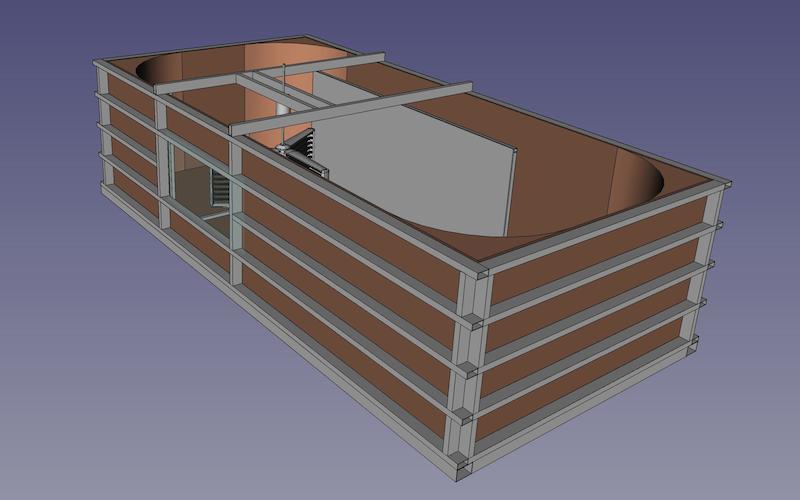
Laminar Flow Test Tank?
The Laminar flow test tank will be 10? x 20? x 5?deep with an over tank work platform and a 30? x 60? viewing window in the side. The test tank will be built from a steel square tube frame lined with multiple layers of marine plywood and coated with a liquid rubber membrane. After pricing a number of “prebuilt” test tanks, we decided to build our own tank to conform to our limited budget. The water flow in the tank is generated by four 5hp pumps arranged to turn half of the tank into a eductor, so we can use a small fast flow of water to circulate a large volume of water in the tank. Once again, the improvised eductor arrangement was decided on to fit the budget. The tank will be built where it can be transported by Semi truck, and when we have completed using it for testing, we will donate it to the Florida Atlantic University Southeast National Marine Renewable Energy Center.
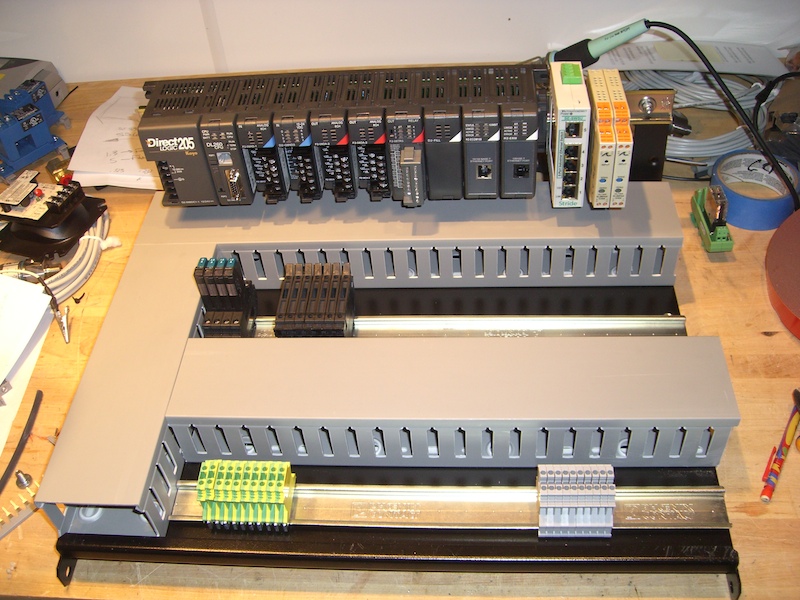
How will you collect Data?
The data collection and control will be analog / digital interface to a custom LabView application. If funds allow we will output real-time data to our website with a special page for monitoring turbine output.
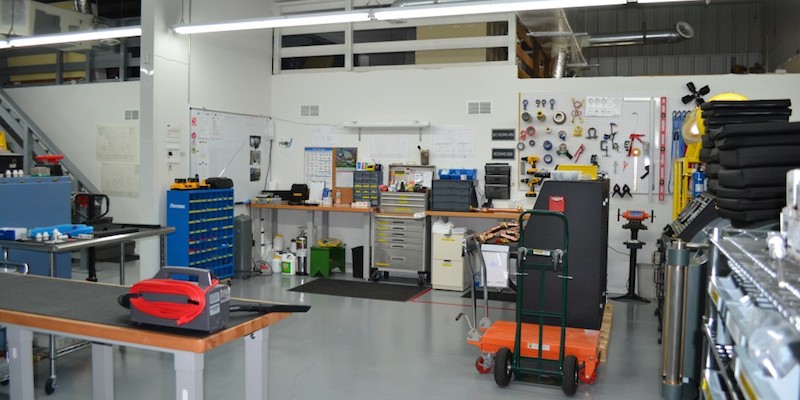
Where will the prototype be built and tested?
At the moment we are being provided a workspace by a local manufacturer in Zephyrhills Florida, and while small, it is adequate for construction of the turbine prototype and test tank. As we grow we will need to look for a warehouse space near Florida Atlantic University and in close proximity to the Atlantic Ocean.
Additional Technology Information:
We have been asked to provide additional technical details about the turbine and generator. We will be updating this section with ongoing specs and data.
Eco Friendly Generator: The generator module has been specifically designed for the Ocean Energy Turbine. It is the result of eight years of research and testing. Its primary goal is to not create any negative impact on the marine environment. The second goal is to reach the maximum possible efficiency while providing decades of reliable service in a harsh ocean environment. To achieve these goals required development of new technology.
Magnetically Shielded – The Ocean Energy Turbine’s generator is designed to be completely magnetically shielded. This shielding prevents the generator from producing any rotating magnetic fields or transverse electromagnetic radiation that could affect the surrounding marine environment. The power transmission lines are also shielded to prevent electromagnetic radiation. Every effort has been made to ensure the protection of the environment.
Direct drive – By designing around direct drive technology we have greatly reduced the number of moving parts and greatly increased long term reliability. Direct drive drastically reduces service and maintenance intervals resulting in reducing potential down time. Direct drive is also an average of 30% more efficient than conventional transmission and variable torque power generation.
Harmonic Damping – The Ocean Energy Turbine’s generator is designed to have one moving part that is precision balanced for the reduction of harmonic vibration. The absence of brushes, commutators, clutches, gears, and transmissions in the generator design allow the generator to produce maximum power without producing vibrations “noise” that could disturb the marine environment. CrowdEnergy is in the process of filing a number of additional patents covering technologies that are unique to the Ocean Energy Turbine and its generator.
Costs?
Q: What is the cost of one of those turbines to build and put into water?
A: Crowd Energy would feel more comfortable answering that once we build the mid size turbine and install it at FAU.
Q: Do you anticipate the cost of laying and maintaining power lines to these generators being prohibitive, especially with the corrosive effects of salt water?
A: Not at all. The power transmission technology is the same as use by offshore wind farms which is an existing proven technology. We aren’t rebuilding the car, just the engine.
Q: How are you able to finance such a massive project if your are not supported by the government or a large company?
A: We are building and installing the medium sized production turbine at the Florida Atlantic Open Water Test Station that will allow us to attract enough investment interest to fund construction of the first full size production turbine. At that point we will need government / corporate funding.
Maintenance and Sea Growth?
Q: How will you discourage growth and debris from being caught or jamming the turbines.
A: In the past 10 years there have been great advancements in anti-biofouling non toxic mating coatings for materials susceptible to corrosion.One such coating is nano-carbon composite that creates a surface that marine organisms can not efficiently attach to. The only part of the turbine that will not be in constant motion will be the base column and it will be subject to marine encrustation. The base column becoming encrusted with marine organisms will not produce any negative effects on the operation of the turbine. Remember, we’ve been in the subsea business for quite a long time, this is all proven technology.
Q: How do the materials stand up to the corrosion factors in the salt environment. Anything in the ocean eventually gains critters or debris on it, how does your material choices hold up to 5-10 years down the line?
A: The majority of the components used in the production scale turbines will be non corrosive metals and high performance composite fiber. We are selecting proven materials that should provide for a minimum 25 year lifespan. However, It will last much longer with proper maintenance.
Q: What degree and frequency of maintenance do you foresee for these units?
A: Most of the systems on the turbines have been simplified to require as little maintenance as possible. Each blade module is composed of the blade, blade shaft, blade bearings, and blade bearing cups. Each blade module can be ejected and replaced by ROV. This system allows for almost all of the wear surfaces to easily be replaced in the field by robotics.
Q: What’s the lifespan on the turbine while in use in the ocean. How do they stand up to sea life and disasters like oil spills and hurricanes?
A: The turbines will be designed for a minimum 25 year lifespan. In regards to any outside variables, the turbines are installed at a depth that is completely unaffected by surface storms such as hurricanes and typhoons and surface debris like oil spills. Remember, these turbines are on the ocean floor, nowhere near the surface.
Q: How do you plan to combat the growth of barnacles and other adherents to the turbine? Traditional anti-fouling uses chemicals damaging to the environment and even then boat bottoms have to be scrubbed regularly
A: All the coatings we use are state of the art non toxic marine coatings. Objects moving at greater than 4 knots typically do not suffer from marine organism encrustation. Marine organisms need a low water velocity in which to effectively attach to an object with their biological cement. The only part of the turbine that will not be in constant motion will be the base column and it will be subject to marine encrustation. The base column becoming encrusted with marine organisms will not produce any negative effects on the operation of the turbine.
Q: How about seaweed? I have seen on the beaches and oceans of Florida and other states some pretty gnarly seaweed, long and strong that could easily wrap around your turbines and stop, maybe even damage them. Are they immune to this, or are you guys thinking of putting a fence around it to protect it against larger debris like that?
A: No worries, a megawatt scale turbine would not be stopped by seaweed. We are working with marine conservationist to select areas where there is very little marine life and flat sandy bottoms. Additionally, the high velocity zones where we collect the most energy are usually devoid of marine life.
Q: Have you done any long term testing in the ocean? If so was there any problems with bivalve, sea weed, algae, of similar stuff growing on the turbines?
A:We have been building , installing , and maintaining structures in ocean environments for over 40 years. We have a lot of experience with salt water compatible materials and cathodic protection.The production turbines will produce very little noise but they do have a very large surface area that most marine life will be able to detect from a great distance through echo location
Q: How will you deal with bio-fouling (filamentous algae getting trapped in vents, barnacle/mussel/drill worm/algae growth, etc.)? I know scientists who have been working with biofilms & preventing growth on ships but don’t know if that research is useful for your project.
A: In the past 10 years there have been great advancements in anti-biofouling non toxic mating coatings for materials susceptible to corrosion. One such coating is nano-carbon composite that creates a surface that marine organisms can not efficiently attach to.
Q: What kind of plans do you have about maintenance. In heavy currents I bet it’s hard to place the equipment there, but maintenance will be tricky too
A: We will be able to slow down and stop the turbine to do any maintenance. Additionally, the ROV’s can be tethered to the turbine during maintenance if needed.
Q: What process and mechanisms have you designed for recovery and recycling of failed or spent Ocean Energy Turbines? How would including the cost of “disposal” after use affect the cost of the Ocean Energy Turbine, in particular as compared with the as yet unincluded cost of environmental harm in fuel-generated power.
A: The Ocean Energy Turbine is modular in design so each component is replaceable as needed. The Ocean Energy Turbine is also composed mostly of metals and composite fiber, both of which are 100% recyclable. Currently we are currently working with a company in the development of 100% electric support / maintenance boats.
Q: Question about the basic design, as compared to other, axial-flow turbines: Are you worried about flotsam and small animals getting stuck between the louvers and preventing them from completely closing? Will the final version incorporate sensors to detect this?
A: This will not be a problem. The production turbines will have a very large gap ( 4 meters / 13 feet) between blades when the blades are open. Also, 99.9% of all sea life would be able to pass through the open blades unharmed. The turbine rotates at the same speed as the current so for a marine creature to get stuck between blades would require that creature to deliberately maintain a position between the ballads as they were closing. Additionally as the blades close they produce a positive pressure ahead of the blades which would push out ( self clean ) anything between the blades as they were closing.
Q: What are you doing to isolate your steel ball bearings from your aluminum frame? I can see that most of the parts are aluminum, but how will those not get gunked up in seawater. Is 6061 anodized the best choice for a corrosive environment?
A: All dissimilar metals are isolated with a dielectric coating. Aluminum was the best choice for prototyping the test turbine. Larger turbines will be mostly stainless and composite.
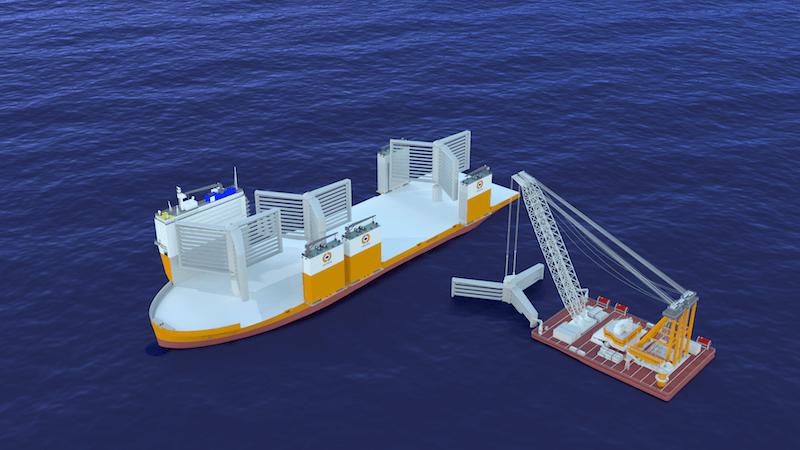
Design/Function?
Q: Could these turbines be scaled to a size which could be attached to the hull of a ship below the waterline and reclaim part of the energy used to propel the ship?
A: It can not. This would create drag on the ship causing it to burn more fuel
Q: How much energy does a turbine produce per hour/day/month?
A: It Varies. For example an Ocean Energy Turbine with a 30 Meter blade span in 3 Meter per second flow will produce 13.5 Megawatts and power 13,500 average american homes.
Q: What size is the generator of the current model?
A: The first prototype is 52” in diameter. The production turbine will have 30 meter blades. There will be a number of different sizes of turbines for specific applications.
Q: What is the anticipated capacity factor?
A: the capacity factor will be very high because ocean currents produce a consistent flow 24 hours per day. The Turbine will operate at near full capacity all of the time.
Q: What size generator do you hope to build in the “production” type model?
A: Minimum of 13.5Megawatt / 30 Meter blade length
Q: What is your goal in terms of $/MWhr, and what is your plan to get it there?
A: 13.5Mw per hour per turbine
Q:How will you transfer the energy from the turbine to the shore then to homes?
A: Subsea power transmission cable manufactured by ABB to a shore base grid tie connection will transfer the power. Siemens and ABB have existing technology to safely transmit utility scale electricity underwater to shore. It is a product used in offshore wind farms. The shore grid tie system consists of grid tie inverters and output metering – all existing technology.
Q: How does your prototype compare to other ocean energy prototypes currently under development?
A: Our limited competition in the field of ocean energy has mostly tried to adapt existing wind turbine technology (propellers) to the marine environment. As water is 1000 times more dense than air, this has resulted in designs that are not optimized for collecting high density ocean energy, nor friendly to the marine environment. We decided to use our collective experience in the marine environment to design a turbine that was specifically optimized for collecting high density energy from ocean currents, while not damaging the marine environment. Our optimized high surface area design will allow us to collect up to thirty times the energy of propeller based designs in the same device footprint. This power density will make ocean renewable energy a financially feasible energy source.
Q: For the US, do you happen to know roughly how many quad BTU’s could potentially be generated yearly, given the square footage of US controlled ocean floor?
A: We do now know.
Q: Are you not better off trying to develop an ocean current technology based on lift instead of drag?
A: We have over the last ten years looked at other potential designs and from testing found this design to be the most efficient at converting ocean currents into usable electricity.
Q: How do you plan on fixing it to the ocean floor? Will buyers be able to fix (anchor) it to any type of ocean floor? Muck? Or only solid rocks?
A: This has actually been done before, and we will be using existing technology to mount the turbines. We will use pier, pad, or tension leg technology where needed similar to the mounting of an oil platform.
Q: If there is power loss along the transfer wires, will these be located primarily near coastal cities?
A: Most will be located along the coastlines and there is very little line loss. There has also been large innovations in the HVDC technology sector (High Voltage DC Cables)
Q: How can your turbine generate as much energy as 30 propeller type turbines on the same footprint?
A: Our turbine has up to 30 times the surface area of a propeller base turbine design
Q: Will the temperature of the water affect the power output or current flow?
A: Water temperature will have no effect on power output
Q: Why choose a 3 fin turbine?
A: 3 sets of blades was the most efficient design in our testing and calculations
Q: Have you conducted a lifecycle analysis?
A: This is one of the things we will do with the mid sized turbine once installed at FAU
Q: How will you distribute the energy to homes and places away from the coast?
A: We will use the national power grid
Q: Since there is a maximum fraction of kinetic energy that can be extracted from any flow, then if you try to extract more, the fluid has no energy left to go anywhere. Does this have any effect on the energy output?
A: Water at depth acts differently than water at the surface because water at the surface can displace the air above it (move around objects with more ease).
Q: What kind of numbers for power generation do you have from your test?
A: The results are up to 15kw per square meter at 3 meter per second flow. And there is very little speed reduction.
Q: How much does the turbine reduce the speed of the water behind it?
A: Very little. The turbine moves at almost the same speed as the flow
Environmental Impacts?
Q: When this becomes a large scale operation and there are say a hundred of these turbines in an area, would it be possible that it could affect the ocean current flow to an extent that might be concerning?
A: Not at all. You would run out of building materials on earth before you built enough turbines to have a negative impact on the oceans currents. Ocean currents are in part due to the gravitational pull between the earth ,the moon, the sun, and other planets. This makes it a truly renewable energy source.
Q: If these are implemented on a massive scale in just one area, what is the potential impact of the induced drag on the current in that region? If not introduced homogeneously, is there a possibility for current shift?
A:The turbines are not a static obstacle to a current they move with it. Additionally, you would not be able to build enough turbines to create a current shift.
Q: Where will your salt go from desalination? How will it impact the nearby marine ecology? What is your projected data on the fresh water project and it’s effect on the ocean(near and far)?
A: So we have two choices for this. Option 1: Because the turbine will be operating in high velocity current any brine produced by the Reverse Osmosis can be released downstream of the turbine through a diffuser system and will almost immediately be titrated into the water column without creating any pockets of abnormally high salinity. Option 2: The brine can be pumped to shore where it can be dehydrated and sold as a raw material.
Q: Have you considered fail safes for wildlife interruption? In the matter of a worst case scenario involving electric current relinquished into the ocean, what kind of consequences would result?
A: Salt water and the seafloor are inherently good paths to ground for any stray potentials. Stray potentials are typically not able to radiate in significant distance due to this fact. Ground fault interrupt power transmission systems will be used on the turbines.
Q: Would the funders of this project be able to benefit before other people with no link in supporting this project?
A: We are looking at the option of providing additional investment opportunities at a later stage of the project to the founding funders.

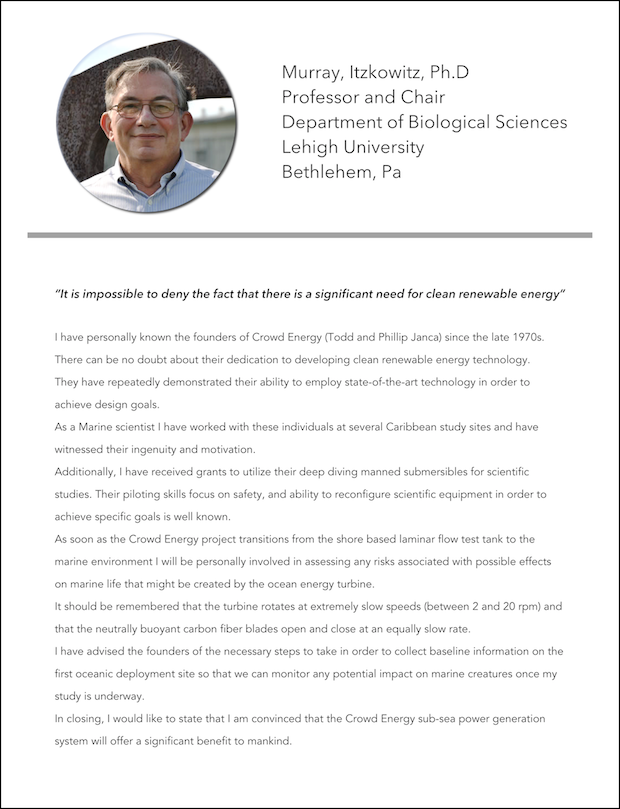
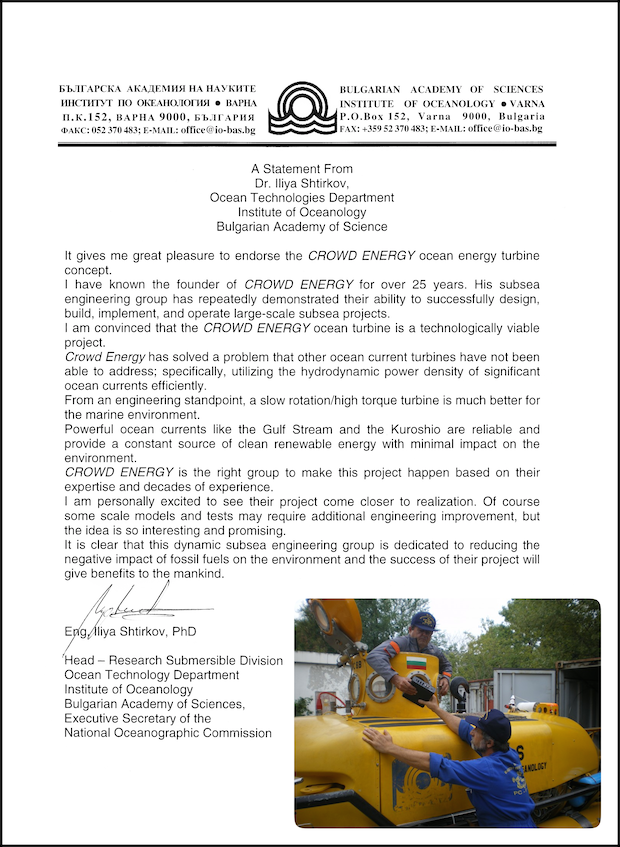

Mark Ruffalo
Matthew Modine
Robert H Lambert
Fred Kitto
Justin Kennedy
Lester Ward
Stuart Reyner
FirstLady O.
Ronald Ostlund
Sam Mathis
JOHN COSTELLO
Trevor Thomas
Edwin Brooks
Cooper Johnston
cody ault
William Cawley
Rebecca Yeager-Piazza
Lorenzo Carmagnola
paul schmitt
David Freeman
Marc Landblom
Anthony Devlin
Edward Allyn
Franklin LaVoie
chad stephens
David Quattro
Tyler Watts
George Risberg
Shane Neph
aileen moran
David Lange
Damien Betner
Alessandro Abate
Harry Somma
James Zampathas
Thomas Janssen
Mick Wainman
Steven Moore
Todd Janca
David Trapp
Ed Wright
Steve Cullen
Ty Markham
John Cole
Colin McPhillamy
Gray Russell
Jim Knight
John Narby
Donald Kjenstad
Richard S. Blankfein
Daniel Erway
David Howell
Michael Jordan
Darryl Duffe
Aron Scott
Raymond Zwack
Aaron Barnhart
Trey Knight
Joseph Felece
robert meredith
Robert Whitney
Robert Dziegiel
EDWARD VAN AELSTYN
James Kahn
Randall McCluer
Joel Goldblatt
WILLIAM POWERS
Paul Fitzpatrick
John Roblin
Brad Woelke
Roger Henry
Neil Bresnahan
Rick Ewing
Daniel Netherby
Fred Schein
Connor Moss
Richard Day
Steve SMall
Derek Batting
Jack T Hendrick Jr
Michael Teaney
Steven Wolverton
Gerald Milnes
Teresa Michele Douglas
george petrakis
jp taxman
Bart Grossman
Mark Landrieu
Ragnar Bohlin
EM Rickman
EM Rickman
Todd W Lund
Bradley Murphy
Scott Stevenson
Bruce Binder
David Strine
Bruce Hulick
Terence Karkabe
mary hershelman
James Dionne
Kristene Geering
Ron Heiman
Patrick Hasson
Kenton Glick
Christ Andronis
Kelly Craig
robert atkinson
Sean Tait
Robert Jacobs
Katie Msabaha
Rebecca Read
Helena McCallum
Robert Barnes
JOSEPH MCCORMICK
Mary Beth Hollenbach
Todd Hunt
Jonathan Sifuentes-Winter
Jefferson Douglas
Susan Wilkins
Darrin Norcutt
Paul Laplante
James s Miller
Guy Castonguay
Brendon Kauffman
Michael Martine
luke feather
Kelly Umlah
Stephan Pridonoff
Erwin Ramthun
David Baker
GUIDO JONES CARTER
Adam Fedak
David Lockman
Ivan Freedman
Derck van Schuylenburch
William Padgett
Audrey Harty
Roxann C
Jacob Anderson
Mark Barabasz
Craig Mullins
Janel Carpenter
Larry Munchrath
James Pasell
Sherre Boothman
Katherine Martin
Bill Huitt
kees veldkamp
Thomas George
john barton
Nathan Papke
Jim Ounniyom
Ryan Jense
Garret Lopata
Greg Harris
S. Shoup
Dave Kolars
Lora Chamberlain
Stan Shafer
Hein Bloem
Nathan Fandrich
Kent Melcher
Pierre Gilbert
Lee Bunnell
Steve Miller
Dylan Croeker
Philip Delaplaine
Isaac Henry
Hunter Maret
Gary OConnor
Ron Iacopucci
Steven Adams
Herbert Brentlinger
Mary Mobley
Katherine Morgan
Bruce Moody
Mary Garoutte
gary stuart
Craig Anthony
KATHRYN NILSSON
Gabriel Adame
Jeanne Jensch
Zach Schiller
John Baldwin
Barbara Morris
Carol Bush
William studebaker
HANK LENGFELLNER
Jurgen Lobert
Neal Winblad
Mike Cowan
Michael Muench
John Fine
Tony Grocki
Brandon Amos
Shailender Karur
Elizabeth Collins
Don Loftin
Todd Janca
Thomas Bernardy
Jon Litorja
Matthew Potter
James Little
ronald robinet
Keith Nohe
john burkholder
James ONeill
Tom LaGrassa
Lucinda Olney
Ellen Geismar
Ticsco Campbell
james weir
Clayton Stokes
Alejandro Diaz
linda oakey
David Percival
oscar camarena
James Reeder
Steve ONeil
Kathleen Nichols
Jo Ann Bertollini
Leanne Sarkisian
James Reynolds
Jon Wilson
Jeremy purdom
Johnny Osborne
Connor Vanecek
David Philpot
William Oakley
Thomas Manes
Joseph Corley
Nutan Joy
Eduardo Smith
Blake Miller
Alan Robinson
Roland Cabral
Dario Idzakovic
Rainforest Connection
Rebecca Riley
Jeremy J Lauten
Cole Holden
Pauline Thornham
Trudi Sorensen
Ciara Caneega
Frank Galea, CFA
Lindsay Kent
Dan Boivin
Patrick Harrod
Daniel + Cristina Figlio
Jared Flynn
Kathy Schlegel
Dave Chambers
Jessica B. Reel
Michael and Nicolle Cannon
Chris Means
Kyle Summers
Gregg Radell
David Freeland
Honorah ONeill
Kristine Fink Benitez
Ruben D. Lewis
Dawn L Cline
Arto Peltomaa
Yojan
Jimmy Brissman
Nate Zeleznick
Jan Jacob,
Ram Moola
ABello
Carolyn Canfield Cole
Randy Sikk
Santiago E. Lopez-Arauz
Anastacia E. Gutierrez
Supported by Steve Biddick and family
Bill Laing
Warren Sander
Marianne J Warhol
Konattitude
Nicole Sedgeley
Jim & Michelle Marquette
JRosen
Amy Mandel and Katina Rodis
Carol L Nicholson
Jason Lankford
Benjamin Foxman
John R. Olley
Diego Rodrigue
Kenneth L. Maples
brian davis
Benny S.D.
Richard Sanders
Rob Rey
Jonathan Schwilling
Bonnie Bowen
Samuel D Brannon
Adam D Rubinstein
Jim Bencie
Cassie L. Taylor
Jimmy Mei
David C Kressin
Zink
Lin McNulty
Joan Miller and Steve Wood
Tim DeChristopher
Nicole Wijngaarden
Ben Perkins
Star Childs
Ian Caterina
Sascha Stanton-Craven
JD Hill
Alan Gruskoff
Mark Moura
Holly + Wally Wallace
Joel Wilkinson
Ocean Energy Turbine – Climate Change Solution Indiegogo
